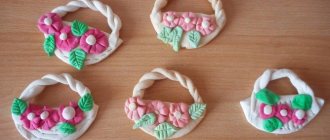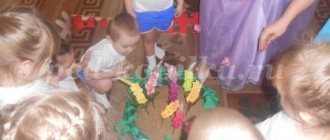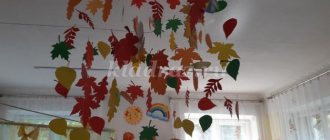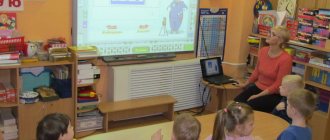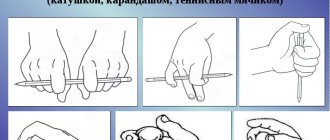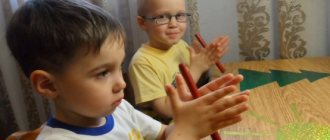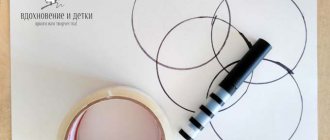06.02.2020
What to do with children at home, on the road, on the street
We live in an amazing time when we have everything to develop a child correctly, quickly and interestingly. In the store you can buy any educational game for motor skills, memory, logic, speech, etc. But! Dear moms, you can make more than half of these games with your own hands. At the same time, one razvashka will take you no more than 20-30 minutes, and sometimes 5-10 minutes. Moreover! We have put together a collection of educational games for kids 2-3 years old, 4-5 years old. They all look very bright, colorful and interesting for children. You can make them with your child as a craft, and then play for many months. This way you will have fun, develop new skills and save money on toys!
Many educational games, by the way, are much more interesting than store-bought ones, are made from simple materials and children like them much more!
Interesting educational games for your child!
Collection of educational toys for developing fine motor skills
1. DIY game for children made from boxes and straws
Very easy to make with your own hands in 10-20 minutes.
Materials: shoe box and a set of straws.
Make holes in the bottom of the box and color them with different colored markers to match the color of the tubes.
Ready! The educational toy for kids is ready! The child will be happy to play every day for 20-40 minutes a day, develop fine motor skills, remember colors and get acquainted with new objects.
2. Developmental game for children 3-4 years old
Easy to do with your own hands.
Materials: colorful bottle caps and cards.
Make cards with circles of certain colors. Now on each card you need to arrange the lids by color. If you have 2 children, play for a while and be sure to reward the winner and support the losing child.
3. Do-it-yourself educational toy for kids 2-4 years old
Manufacturing time: 10-15 minutes.
Materials: colored paper, album sheets, glue, stationery.
Draw or stick circles of different colors on a piece of paper. Make strips of paper in different colors. Ready! Children must glue the ends of the strips into circles that match the color.
4. Labyrinth toy for motor skills development
On A4 sheet or cardboard, draw or stick a labyrinth. Color it. Now the child must use his fingers to reach the end of the maze. Children love this game very much!
5. Tube game for kids
Materials: tubes and toilet paper roll base.
At the base of the toilet paper roll, make circles the size of the tubes. Ready! It turns out in 7-10 minutes! Now the baby must insert the tubes from the hole of the roller. We develop fine motor skills and learn colors.
5. DIY game made from clothespins and a box
Today we are building a house out of clothespins. Each wall should be a certain color. The child must attach clothespins to the sides of boxes of certain colors. We develop attentiveness, logic, fine motor skills and have a good time!
6. Puzzles with sticks, repeat the pattern
Draw on paper examples of what the child should build from sticks. The game develops not only finger mobility, but also logical thinking.
6. DIY board game “Labyrinth”
Make a labyrinth out of material or paper as shown in the picture. By the way, you can draw the labyrinth yourself with bright colors or felt-tip pens. And now the child must guide a ball, a small toy, or a button through this maze. A very exciting development for motor skills, logic, and the thought process.
8. Homemade educational game from pasta tubes
A simple game when you don’t know what to do with your child. Glue large pasta onto a sheet and thread a string through it. The child must thread the string through the pasta to create a beautiful design. You can draw a diagram in advance for your baby to follow to thread the lace. This game is fun and will keep your child busy for more than 20 minutes. Develops logic, fine motor skills, and grasping skills.
9. Finger motor skills development for kids
Make a ladybug or apple applique as shown in the picture. Glue the corks to the image as in the photo. Now the child must decorate the photo by threading a string through these curlicue plugs.
10. Developmental game for children 3, 4, 5 years old to learn letters.
Mark the letters on the clothespin and box, as shown in the photo. And now the child will look for the correspondence of the letters on the box among the clothespins. When he finds the right letter, have him name it. You can also use this development tool to study syllables. Write the syllables on the box and the baby will look for the necessary letters and read the syllables.
What teaching aids can you make yourself for kindergarten?
Language development is not an isolated skill. To a large extent, it is determined by the general level of development of the child and, in particular, his intelligence.
Didactic manual on speech development
Activities that improve sensory and fine motor skills in children are of great importance in this process. For this, it is important to use teaching aids, a significant part of which can be made independently.
Children's learning, especially in junior and middle groups, should take place in a playful environment, otherwise they will lose interest in the subject and time will be wasted. For teaching to be effective, the teacher needs to use all available means to maintain the child’s useful activity.
Didactic materials for sensory development
The “Flower Petals” manual looks like this. A circle is attached perpendicularly to the straight stem. The edges of the central part are covered with Velcro. Several petals with images of objects or fairy-tale characters are offered. This fabric is also attached to the inner edge of each of them. The task is to find the petals with the corresponding words based on the letter drawn on the mug and attach them to the central part.
The game “Blow out the insects into the clearing” is designed to develop speech breathing. For this purpose, the “Polyanka” manual is used. It is a low box with high sides. Small cardboards with images of animals are suspended on short threads from the outside. The child must blow them out, but does not have the right to puff out his cheeks.
Important! In this way he is taught how to breathe correctly during a conversation.
The game "Clothespins" is made using the same manual. For this, the kids are given several colored clothespins and asked to build a fence. They place them on the edges, while loudly calling out the color used.
There are two horizontal lines of Velcro glued to the outer wall of the Polyanka manual. Each row contains four cards with images of animals, fairy-tale characters or objects. The child is told that in each row one of the pictures is extra and is asked to remove it. Then he should tell what the remaining images have in common and why.
Lesson with children
Iconic didactic materials
One of these multifunctional aids is “Teremok”. It is a fabric house attached to a flat, solid base. It has a large number of pockets sewn into it, in which various pictures are placed. They can depict objects of the surrounding world, fairy-tale characters from the fairy tale of the same name, images of letters or syllables.
How to make a lapbook for speech development with your own hands in a preschool educational institution
There are various ways to use this manual in kindergarten.
Here's one of them. Children are shown pictures taken from a pocket attached to the tower. They ask what fairy tale this hero, who is depicted on the card, came from. The child must remember the name of the fairy tale and try to retell its content.
Important! If the child needs the help of a speech therapist, then it is provided. During the story, the teacher asks the child simple leading questions.
You can also use this manual in a preschool educational institution as follows:
- The teacher takes out cards showing the inhabitants of the tower, but does not show them. He depicts the sounds these animals make. The child must repeat them and name the hero of the fairy tale who is depicted on the card.
- The manual can be used to study prepositions that show the relative position of cards. The teacher places cards with pictures of animals in various pockets and asks questions about who is located where. The child must answer using the prepositions “above,” “under,” or “between.”
- Then the child is asked to formulate questions using the mentioned prepositions and ask them to the teacher.
Another task is the following:
- The child is given cards with images of fairy tale characters and asked to place them in various pockets.
- After this, the kid must say which animal lives on which floor and who is to the left, right, above or below him.
Mobile development toys for children 3-4, 5-6 years old
11. Mobile development activity “Place the toys in circles”
Children have to try to see who can quickly place the objects in circles on the floor. These can be circles, ovals drawn or glued from tape. These games are suitable for holding competitions at children's birthday parties.
12. Outdoor educational game “Traces”
Children really like outdoor games, so you can cut out colorful footprints and put them on the floor or on the ground outside. The child must repeat what is indicated on the footprints. A fun game to develop mobility and thinking.
13. Mobile wiggle “Throw in the ring”
13. Outdoor educational game “Arrange objects by color.”
Prepare the game as shown in the picture. Now the child must arrange the objects into multi-colored squares according to color. Interesting idea for studying flowers.
14. Educational game with a cube
Draw hopscotch on the floor or ground. Each child should have their own path. Now throw the dice and according to the figure that appears on the cube, the child must move along his line.
Developmental games for developing thinking and hand motor skills
15. DIY activity “Traffic Eater”
16. Developmental activity “Spread the seeds on watermelons”
Make watermelon slices as shown in the photo. Now the child must arrange the seeds into a certain amount. In this game, children quickly learn to count.
17. Developmental “Palms” Learning to count.”
Throw the dice and select the number on the side of the cube, bending your fingers over your palm.
18. DIY educational game “Find a match and arrange according to the picture”
19. Developmental “Making a face. Find a match"
20. Developmental activity “Making bugs out of plasticine”
21. Developmental “Learning letters and looking for matches”
23. DIY educational toy “Book for fine motor skills”
Nowadays they sell a lot of developmental boards for fine motor skills. But, dear mothers, you can make one yourself, as shown in the picture. Of course, you will have to spend more time, several hours. But your child will enjoy playing for many months and develop motor skills, thinking and speech!
Where are teaching materials used?
The use of hand-made speech development aids for preschoolers creates a playful basis for working with them and determines the storyline of the lesson. A child, especially in the junior and middle groups of kindergarten, thinks concretely, using images, rather than abstract logical constructs. He can react to assignments received from a speech therapist or teacher, being a participant in a specific, albeit fictitious, situation. The teaching aids serve as the factual basis for their learning each year.
Speech development based on visual cues
When a child learns to express his thoughts, he must follow a certain pattern of expressing his thoughts. For a child who is almost unable to concentrate on one subject at his age, this is impossible. Using teaching aids in the form of cue cards helps build a story line. For younger children, we are talking about much simpler things. They simply have to name the objects or briefly describe the actions with the cue cards.
Speech therapist works with a child
For example, in the didactic manual “Zippers,” the child must choose among the open colored zippers lying on the table those that correspond to the teacher’s instructions and close them. At the same time, the child describes his choice, its reasons and the actions he takes.
At an older age, each visual cue can be used together with leading questions from the teacher and be the basis for a coherent story. This can be seen, for example, in classes devoted to professions.
What to do if a child speaks poorly at 4 years old
Every description of your actions, answer to a specific question, or short story based on visual cues helps your child better develop his speech skills. Serve as preparatory exercises for adult life.
Learning to retell
The development of coherent speech in children is one of the most important skills that a child must be taught. Without mastering it, he will not only not be able to develop properly intellectually, but also will not be able to fully socialize, not being able to conduct a dialogue or express his thoughts.
When retelling, the child must create a coherent, long story. However, for this he will need tips, which can be received during didactic games and from the teacher.
The development of fine motor skills plays an important role in this process.
Important! By engaging in retelling, you will be able to strengthen your speech and intellectual skills and increase the level of development of your personality.
Learning to think
Human speech is closely related to thinking. The same is true for a child. Communication is not limited to expressing your thoughts or describing actions. The level of speech proficiency is largely determined by the degree of development of the child’s personality and thinking.
Do-it-yourself teaching aids for kindergarten can be used not only for stories, but also as an excuse to ask your child questions about cause-and-effect relationships in the world around him. For example, using cards related to the plots of fairy tales, you can ask questions about the circumstances of the characters’ actions, the reasons and consequences of their actions.
You can combine the classes in question with the study of mathematics.
In addition, the educational function of speech development classes is important. For example, if a child is asked questions about the features and beneficial properties of the plants depicted in the pictures, then gradually this knowledge will be consolidated in the child. If additional questions are asked about this material, the child’s knowledge will become more detailed and practical.
Preparing for literacy
To do this, you need to learn not only oral speech, but also study letters and words. Children of senior preschool age, with the help of a teacher and parents, are able to master the alphabet and basic reading skills.
For this purpose, a do-it-yourself didactic manual on speech development for kindergarten with cards depicting letters, syllables or words can be used.
Picture 4 Speech corner
